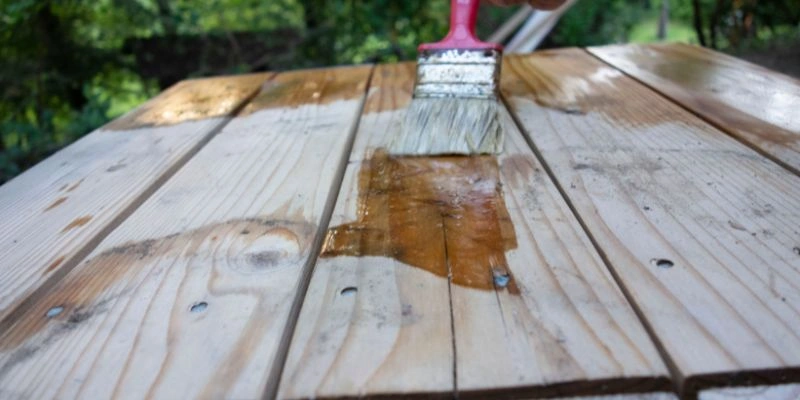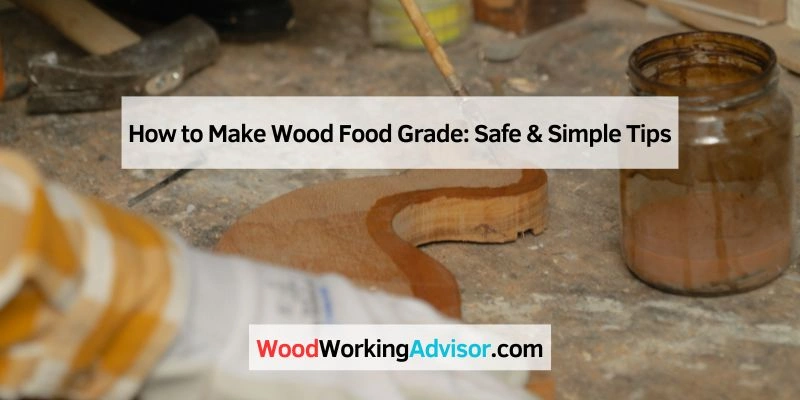To make wood food grade, start by selecting hardwoods like maple or walnut. Then, apply food-safe mineral oil or beeswax to seal the surface.
Wood has been a staple in kitchens for centuries, prized for its durability and aesthetic appeal. Food-grade wood is essential for kitchen items like cutting boards, utensils, and serving trays. Choosing the right type of wood and finishing it properly ensures safety and longevity.
Foods can be safely prepared and served on treated wood surfaces. Understanding the proper treatment methods can help maintain the integrity of wooden kitchenware. This guide will explain the steps necessary to make wood safe for food use, ensuring a healthy cooking environment and extending the life of your wooden items.
Introduction To Food Grade Wood
Wood can be safe for food when it is treated properly. Food-safe surfaces are crucial for preventing contamination. They help keep your food clean and healthy. Choosing the right wood type is important for safety.
Different types of wood have unique properties. Some woods are naturally resistant to bacteria. Hardwoods like maple and oak are great for cutting boards. They are durable and easy to clean. Softwoods, such as pine, can absorb moisture and may not be safe.
| Type of Wood | Properties | Food Safety |
|---|---|---|
| Maple | Hard and dense | Highly recommended |
| Oak | Strong and durable | Very safe |
| Pine | Soft and porous | Not recommended |
Selecting The Right Wood
Selecting the right wood is very important. Hardwoods are better than softwoods for food contact. They are denser and last longer. Hardwoods like maple, oak, and cherry are great choices. They do not absorb moisture easily.
Softwoods such as pine or cedar can absorb more moisture. This can lead to bacteria growth. Avoid softwoods for food preparation surfaces. Always choose natural, untreated wood for safety.
| Type of Wood | Best Uses |
|---|---|
| Maple | Cutting boards, butcher blocks |
| Oak | Serving trays, wine barrels |
| Cherry | Salad bowls, kitchen utensils |

Preparing The Wood
Start by cleaning the wood. Use warm, soapy water to remove dirt. Rinse the wood well and let it dry completely. This step is crucial for safety.
Next, sand the surface using fine-grit sandpaper. This makes the wood smooth. It helps to avoid splinters when using the wood for food.
Look for any imperfections in the wood. Fill cracks with food-safe wood filler. This keeps the surface safe for food contact.
After filling, sand the area again. Ensure everything is smooth and even. A well-prepared surface is essential for food safety.
Treatment Options For Food Safety
Natural oils and waxes are great for treating wood. They are safe for food. Common options include mineral oil and beeswax. These products create a barrier against moisture. They also help to enhance the wood’s natural beauty.
Commercial food-safe finishes are another option. Look for products labeled as food-safe. Some popular finishes include polyurethane and shellac. Always check for certifications that ensure safety.
Choosing the right treatment is important for food safety. Proper application will ensure the wood remains safe. Regular maintenance keeps the wood looking great.
Applying The Finish
Start by choosing a food-grade finish. Popular options include mineral oil and beeswax. Clean the wood surface using a soft cloth. Make sure to remove all dust and debris.
Apply a thin layer of the finish. Use a clean, lint-free cloth for this step. Allow the finish to soak into the wood for about 10-15 minutes. Wipe off any excess with a dry cloth.
Repeat this process two to three times for a smooth finish. Each layer enhances the wood’s protection. Let the final coat cure for 24 hours before using the item.
For a smoother finish, sand the wood lightly before applying the finish. Use fine-grit sandpaper to avoid scratches. Always finish with a clean cloth to achieve the best results.
Maintenance And Care
Regular cleaning is essential for maintaining wood that is food grade. Use warm, soapy water and a soft cloth. Avoid harsh chemicals that can damage the wood. Rinse well and dry the surface quickly. This helps prevent moisture buildup.
Reapplying finishes protects the wood and enhances its appearance. Use a food-safe mineral oil or beeswax. Apply a thin layer and rub it in well. Let it sit for a few hours, then buff off the excess. This keeps the wood looking great and safe for food.
Troubleshooting Common Issues
Stains on wood can be tough. Use a mix of baking soda and water. Apply it gently with a cloth. Rinse with water and dry well.
For odors, try white vinegar. Wipe the surface with a cloth soaked in vinegar. Let it sit for a few minutes. Rinse with water afterward.
Scratches can be fixed easily. Use a wood filler that matches your wood color. Apply it to the scratch and let it dry. Sand it down gently for a smooth finish.
For deeper damage, consider sanding the area. Use fine-grit sandpaper to smooth it out. Wipe off the dust and apply a food-safe finish.
Safety Precautions And Best Practices
Always wear gloves and a mask when handling wood for food use. This protects your skin and lungs. Use food-safe finishes to seal the wood. These finishes help keep your food safe.
Keep the workspace clean and organized. Avoid cross-contamination with raw foods. Use separate tools for wood and food preparation.
Common mistakes include using non-food-safe products. Never use regular paints or varnishes. Always check labels for food safety information.
After treatment, let the wood cure fully. This ensures no harmful chemicals remain. Store treated wood in a dry place to maintain its quality.

Frequently Asked Questions
How Do I Treat Wood For Food Use?
To treat wood for food use, start by cleaning it thoroughly. Use food-safe mineral oil or beeswax as a finish. Apply the oil generously, allowing it to soak in. Wipe off excess oil with a clean cloth. This process helps protect the wood and ensures it’s safe for food contact.
What Types Of Wood Are Food Safe?
Food-safe woods include maple, cherry, and walnut. These woods are dense and less porous, minimizing bacteria growth. Avoid softwoods like pine, as they may contain harmful resins. Always ensure the wood has not been treated with chemicals, ensuring it remains safe for food preparation and serving.
Can I Use Regular Oil On Food-grade Wood?
No, you should not use regular oil on food-grade wood. Regular oils can become rancid and may contain harmful additives. Instead, opt for food-safe mineral oil or specialized wood conditioning oils. These products are designed to be safe for food contact, ensuring your wooden items are both functional and safe.
How Often Should I Re-treat Food-grade Wood?
Re-treat food-grade wood every few weeks to maintain its quality. The frequency depends on usage and cleaning methods. If the wood appears dry or dull, it’s time to reapply the treatment. Regular maintenance keeps the wood safe and enhances its lifespan, ensuring it remains in top condition.
Conclusion
Making wood food grade is a rewarding process. It ensures your kitchen tools and surfaces are safe for food preparation. Follow the steps outlined to treat your wood properly. With the right care, your wooden items can last for years.
Embrace this skill for healthier cooking and sustainable living.

